Family

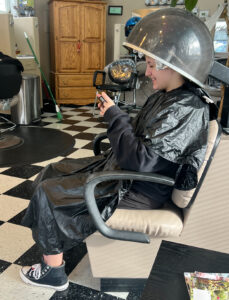 My grandniece, Aleesia Spethman became a preteen this year, but while her mom thinks it seems early, I rather thought she was in her teens already. Of course, when I look at my birthday list, I knew she wasn’t a teenager yet, but she very much looks and acts like she is already a teenager. Her mom, my niece, Jenny Spethman tells me that Aleesia likes the edgy look, so they played around with hair dye. I that that is common with most kids these days. I’m my day it was bizarre to see someone decided to go blonde. Not that people didn’t do it, because they definitely did. Hair dye makes it possible to “fix” the hair color you were born with, into the color your heart desires. These days, the kids, boys and girls alike, like the wild colors, and anything goes. They wear bright red, green, blue, purple, yellow, and anything else that suits their fancy. People their grandparents age, like me, are often caught off guard when we first see someone with purple (or any other wild color) hair, but we are slowly becoming acclimated to this new trend, and Aleesia isn’t a troublemaker or wild child, so hey, go for it…right!!
My grandniece, Aleesia Spethman became a preteen this year, but while her mom thinks it seems early, I rather thought she was in her teens already. Of course, when I look at my birthday list, I knew she wasn’t a teenager yet, but she very much looks and acts like she is already a teenager. Her mom, my niece, Jenny Spethman tells me that Aleesia likes the edgy look, so they played around with hair dye. I that that is common with most kids these days. I’m my day it was bizarre to see someone decided to go blonde. Not that people didn’t do it, because they definitely did. Hair dye makes it possible to “fix” the hair color you were born with, into the color your heart desires. These days, the kids, boys and girls alike, like the wild colors, and anything goes. They wear bright red, green, blue, purple, yellow, and anything else that suits their fancy. People their grandparents age, like me, are often caught off guard when we first see someone with purple (or any other wild color) hair, but we are slowly becoming acclimated to this new trend, and Aleesia isn’t a troublemaker or wild child, so hey, go for it…right!!
Aleesia loves to swim and be in water during the summer. Her parents Jenny, and Aleesia’s dad, Steve 
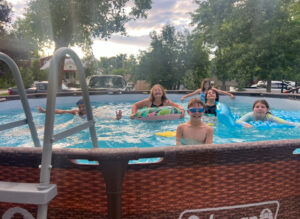 Spethman bought a huge pool a few years back, and boy is that handy. The Spethman house is the go-to place to hang out and cool off, and they all love that. Aleesia’s brothers, Xander, Zack, and Isaac have spent countless hours entertaining their friends in that big pool. Aleesia and her best friend, Hannah spent countless hours in that pool. Aleesia and Hannah spend lots of time together, and it’s a wonderful friendship. This past year, Aleesia also used the pool for something else, when she gave her heart to the Lord and was baptized right there in that pool. Infact, there were a number of us who either gave our hearts to the Lord or rededicated our lives to the Lord that day, including me. We have always been a Christain family, and many of us were baptized as babies, so it was a good time to do an immersion baptism…so we used the opportunity to rededicate. It was awesome!!
Spethman bought a huge pool a few years back, and boy is that handy. The Spethman house is the go-to place to hang out and cool off, and they all love that. Aleesia’s brothers, Xander, Zack, and Isaac have spent countless hours entertaining their friends in that big pool. Aleesia and her best friend, Hannah spent countless hours in that pool. Aleesia and Hannah spend lots of time together, and it’s a wonderful friendship. This past year, Aleesia also used the pool for something else, when she gave her heart to the Lord and was baptized right there in that pool. Infact, there were a number of us who either gave our hearts to the Lord or rededicated our lives to the Lord that day, including me. We have always been a Christain family, and many of us were baptized as babies, so it was a good time to do an immersion baptism…so we used the opportunity to rededicate. It was awesome!!
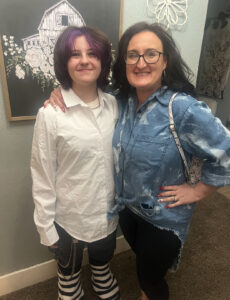
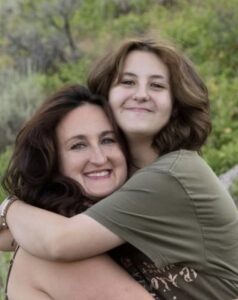
Aleesia and her family are also into hiking, and love to hike on Casper Mountain, which is a favorite of Casper, Wyoming hikers. They hike on the mountain quite a bit, as well as other areas too. It’s a great way to stay in good shape and spend time with the family too. Aleesia has been so blessed by her older brothers. They help her do things and take her places too. There are some great advantages to being the little sister. While having her brothers as friends is awesome, Aleesia is also her mom’s best friend, and that has been a blessing for both of them. After all, in a family of mostly boys, those girls have to stick together!! Today is Aleesia’s 12th birthday. Happy birthday Aleesia!! Have a great day!! We love you!!
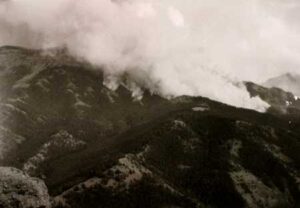
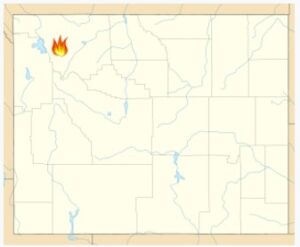 Lightning strikes are a major source of wildland fires. On August 18, 1937, a lightning strike in the Shoshoni National Forest, approximately 35 miles west of Cody, Wyoming, started the Blackwater Fire. During the course of fighting that fire, fifteen firefighters lost their lives when a dry weather front caused the winds to suddenly increase and change direction. The men were caught and had no way out. The fire spread quickly into the dense forest, creating spot fires, that trapped some of the firefighters in a firestorm. Nine of the firefighters died during the fire, while six others died from severe burns and respiratory complications a short time later. Another 38 firefighters were injured. The loss of US professional wildland firefighters from this fire was greater than any other fire in the 103 years between the Great Fire of 1910 and the Yarnell Hill Fire in 2013.
Lightning strikes are a major source of wildland fires. On August 18, 1937, a lightning strike in the Shoshoni National Forest, approximately 35 miles west of Cody, Wyoming, started the Blackwater Fire. During the course of fighting that fire, fifteen firefighters lost their lives when a dry weather front caused the winds to suddenly increase and change direction. The men were caught and had no way out. The fire spread quickly into the dense forest, creating spot fires, that trapped some of the firefighters in a firestorm. Nine of the firefighters died during the fire, while six others died from severe burns and respiratory complications a short time later. Another 38 firefighters were injured. The loss of US professional wildland firefighters from this fire was greater than any other fire in the 103 years between the Great Fire of 1910 and the Yarnell Hill Fire in 2013.
This was not what would be considered a large fire by wildland fire standards, burning only 1,700 acres of old-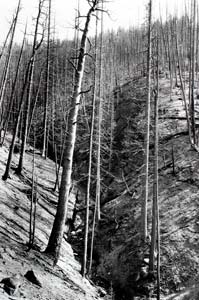
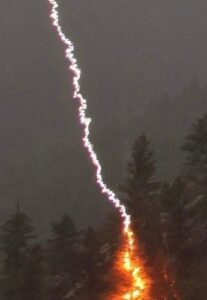 growth forest dominated by Douglas fir trees on the west slopes of Clayton Mountain, but it was by far one of the deadliest. The temperatures that day were about 90 °F, with a relative humidity was only 6 percent. Though most of the firefighters consisted of Civilian Conservation Corps (CCC) employees, they were led by more experienced United States Forest Service (USFS) fire managers. In the first half of the 20th century, firefighters used mostly hand tools to suppress wildfires, and all gear was carried by the firefighters or by pack animals. To further complicate matters, weather forecasting and radio communication were generally poor or nonexistent…leaving the firefighters virtually alone with the fire.
growth forest dominated by Douglas fir trees on the west slopes of Clayton Mountain, but it was by far one of the deadliest. The temperatures that day were about 90 °F, with a relative humidity was only 6 percent. Though most of the firefighters consisted of Civilian Conservation Corps (CCC) employees, they were led by more experienced United States Forest Service (USFS) fire managers. In the first half of the 20th century, firefighters used mostly hand tools to suppress wildfires, and all gear was carried by the firefighters or by pack animals. To further complicate matters, weather forecasting and radio communication were generally poor or nonexistent…leaving the firefighters virtually alone with the fire.
Following the deaths and injuries to the firefighters, the investigation and analysis of the fire and how it progressed, led the USFS to develop better ways to provide a more immediate response to combat fires. The development of the smokejumper program in 1939 was one of the major changes to came about from this fire. Another major change was the Ten Standard Firefighting Orders, a standardized set of wildland firefighting principles, were developed in 1957. “The Ten Standard Firefighting Orders are a set of systematically organized rules designed by a USDA Forest Service task force to reduce danger to personnel and increase firefighting efficiency.” They are: “1. Keep informed on fire weather conditions and forecasts; 2. Know what your fire is doing at all times; 3. Base all actions on current and expected behavior of the fire; 4. Identify escape routes and safety zones and make them known; 5. Post lookouts when there is possible danger; 6. Be alert. Keep 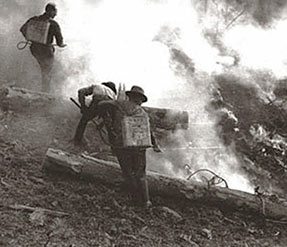
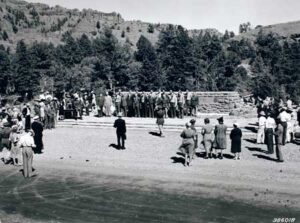 calm. Think clearly. Act decisively; 7. Maintain prompt communications with your forces, your supervisor, and adjoining forces; 8. Give clear instructions and ensure they are understood; 9. Maintain control of your forces at all times; 10. Fight fire aggressively, having provided for safety first.” There is no doubt that these rules and the smokejumpers program have saved countless lives. A year after the tragedy, survivors and their fellow employees constructed several memorials at the scene of the incident.
calm. Think clearly. Act decisively; 7. Maintain prompt communications with your forces, your supervisor, and adjoining forces; 8. Give clear instructions and ensure they are understood; 9. Maintain control of your forces at all times; 10. Fight fire aggressively, having provided for safety first.” There is no doubt that these rules and the smokejumpers program have saved countless lives. A year after the tragedy, survivors and their fellow employees constructed several memorials at the scene of the incident.
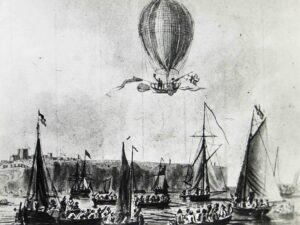 Even before the first airplane too flight, there were people who wanted to be airborne. Human flight first became a reality in the early 1780s with the successful development of the hot-air balloon by French papermaking brothers Joseph and Etienne Montgolfier. Soon balloons were being filled with lighter-than-air gas, such as helium or hydrogen, to provide buoyancy. It was a whole new era. Finally, on November 21, 1783, the first manned hot air balloon took flight. Man could be airborne and come back to earth safely. With that, came the natural desire to try to go higher and further. Man was not done with flight, and in fact this was just the beginning.
Even before the first airplane too flight, there were people who wanted to be airborne. Human flight first became a reality in the early 1780s with the successful development of the hot-air balloon by French papermaking brothers Joseph and Etienne Montgolfier. Soon balloons were being filled with lighter-than-air gas, such as helium or hydrogen, to provide buoyancy. It was a whole new era. Finally, on November 21, 1783, the first manned hot air balloon took flight. Man could be airborne and come back to earth safely. With that, came the natural desire to try to go higher and further. Man was not done with flight, and in fact this was just the beginning.
An early achievement of ballooning came in 1785 when Frenchman Jean-Pierre Blanchard and American John Jeffries became the first to cross the English Channel by air. While early manned flight did occur, it wasn’t the normal mode of transportation. In the 18th and 19th centuries, balloons were used more for military surveillance and scientific study than for transport or sport. As a mode of air travel, the balloon was replaced by the self-propelled dirigible, which was a motorized balloon, in the late 19th century.
While balloons were used for military purposes early on, by the early 20th century, interest in sport ballooning began to grow. Then, the inevitable was offered…an international trophy, to be offered annually for long-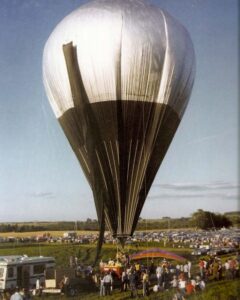 distance flights. Belgian balloonists were the dominate winners of these early competitions, but after World War II, new technology began to emerge, making ballooning safer and more affordable, By the 1960s hot air ballooning enjoyed widespread popularity. There were 17 unsuccessful transatlantic balloon flights from 1859 until the flight of the Double Eagle II in 1978. These resulted in the deaths of at least seven balloonists. One of the unsuccessful flights was in September 1977, when Ben Abruzzo and Maxie Anderson made their first attempt in the Double Eagle I. They were blown off course and forced to ditch off Iceland after traveling 2,950 miles in 66 hours. It was a brutal wait for rescue, and Abruzzo took several months to recover from frostbite that he suffered during the ordeal. Then, by 1978 he and Anderson were ready to try again. With the addition of Larry Newman as a third pilot. The men took off on September 11, 1978, in the Double Eagle II. The flight lifted off from Presque Isle, Maine.
distance flights. Belgian balloonists were the dominate winners of these early competitions, but after World War II, new technology began to emerge, making ballooning safer and more affordable, By the 1960s hot air ballooning enjoyed widespread popularity. There were 17 unsuccessful transatlantic balloon flights from 1859 until the flight of the Double Eagle II in 1978. These resulted in the deaths of at least seven balloonists. One of the unsuccessful flights was in September 1977, when Ben Abruzzo and Maxie Anderson made their first attempt in the Double Eagle I. They were blown off course and forced to ditch off Iceland after traveling 2,950 miles in 66 hours. It was a brutal wait for rescue, and Abruzzo took several months to recover from frostbite that he suffered during the ordeal. Then, by 1978 he and Anderson were ready to try again. With the addition of Larry Newman as a third pilot. The men took off on September 11, 1978, in the Double Eagle II. The flight lifted off from Presque Isle, Maine.
The 11-story, helium-filled balloon made good progress during the first four days, and the three pilots survived on hot dogs and canned sardines. Things seemed to be going perfectly this time. The only real trouble of the trip occurred on August 16, when atmospheric conditions forced the Double Eagle II to drop from 20,000 feet to a dangerous 4,000 feet. To ward off trouble, they jettisoned ballast material and rose to a safe height again. With the added altitude, they reached the coast of Ireland and on August 17 flew across England en route to their destination of Le Bourget field in Paris, which was the site of Charles Lindbergh’s landing after flying solo in a plane across the Atlantic in 1927. In a touching moment, their wives flew close enough to the balloon in a private plane as it traveled over England, to blow kisses at their husbands.
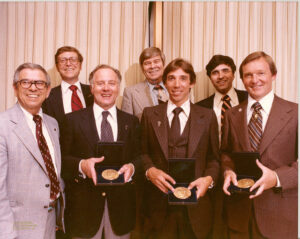
Double Eagle II was blown slightly off course toward the end of the journey, and they actually touched down just before dusk on August 17th, near the hamlet of Miserey, about 50 miles west of Paris. Their 137-hour flight set new endurance and distance records. The Americans were greeted by family members and jubilant French spectators who followed their balloon by car. That night, Larry Newman, who at 31 was the youngest of the three pilots, was allowed to sleep with his wife in the same bed where Charles Lindbergh slept after his historic transatlantic flight five decades before. Transatlantic balloon flight had finally been realized.
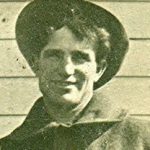
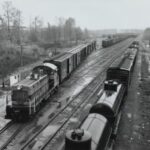 My grandpa, Allen Luther Spencer, like most people worked at a number of jobs. The one I have heard the most about was his time with the Great Northern Railway, where he worked as a carpenter. That put him building and repairing the seats on the train cars, benches in the depots, and much more. Grandpa was an excellent carpenter. He built furniture for the family, including desks, and very likely beds, tables, and chairs. While being a carpenter on the Great Northern Railways might not seem like something exotic or even fun, it did allow him and his family, to travel from Holyoke, Minnesota to Superior Wisconsin so the kids could go to school and into town. Now, don’t think that my dad, Al Spencer and uncle, Bill Spencer demurely boarded the train each day, because they both decided that just boarding the train legally wasn’t the way to go. They
My grandpa, Allen Luther Spencer, like most people worked at a number of jobs. The one I have heard the most about was his time with the Great Northern Railway, where he worked as a carpenter. That put him building and repairing the seats on the train cars, benches in the depots, and much more. Grandpa was an excellent carpenter. He built furniture for the family, including desks, and very likely beds, tables, and chairs. While being a carpenter on the Great Northern Railways might not seem like something exotic or even fun, it did allow him and his family, to travel from Holyoke, Minnesota to Superior Wisconsin so the kids could go to school and into town. Now, don’t think that my dad, Al Spencer and uncle, Bill Spencer demurely boarded the train each day, because they both decided that just boarding the train legally wasn’t the way to go. They 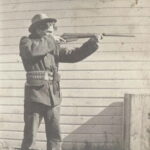
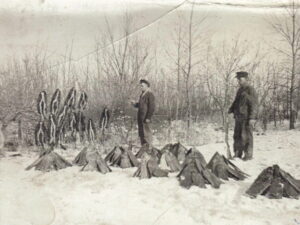 decided, rather that they would take a way to board that was a little bit more dramatic…namely hopping the train. Yes, they hopped on the moving train like they were hobos who shouldn’t be on there. Of course, that brough reprimands from railroad officials, and probably their parents too, but it didn’t stop them. Boys will be boys, I guess.
decided, rather that they would take a way to board that was a little bit more dramatic…namely hopping the train. Yes, they hopped on the moving train like they were hobos who shouldn’t be on there. Of course, that brough reprimands from railroad officials, and probably their parents too, but it didn’t stop them. Boys will be boys, I guess.
Grandpa also worked for a time in the oil fields in Texas, but I don’t know very much about that time in their family life. I know that my grandma, Anna (Schumacher) Spencer and my aunt, Laura (Spencer) Fredrick were there too during those years. Then the family returned to the Superior, Wisconsin – Duluth, Minnesota area and later to Holyoke, where the family 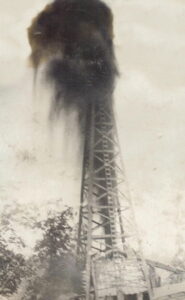
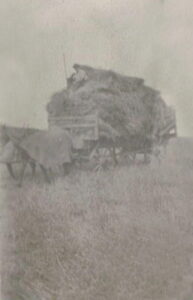 would have a farm, while Grandpa worked on the railroad.
would have a farm, while Grandpa worked on the railroad.
Other jobs he had, were managing a hotel (which Grandma helped with), working in the logging business, the time that he and his brother-in-law, Albert Schumacher decided to go into the fur trade. They actually hunted skunks at one time. Imagine that!! It does go to show that they were determined to make a living, but they nearly froze to death while hunting. That was ultimately what made them decide to abandon the fur trade for the logging industry. Yes, it was an interesting life that my grandpa led. Today is the 145th anniversary of my grandpa, Allen Luther Spencer’s birth. Happy birthday in Heaven, Grandpa. We love you very much, and can’t wait to meet you in Heaven someday.
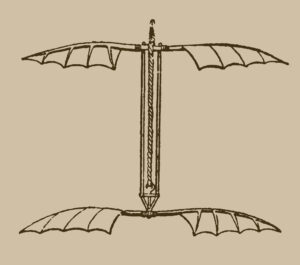
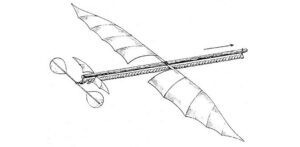 Until I was listening to the story of the Wright Brothers again, I had never heard of Alphonse Pénaud. Born on May 31, 1850, Pénaud was a 19th-century French pioneer of aviation design and engineering. That seems odd, since the first airplane flight was the Wright Brothers in 1903. Nevertheless, Pénaud was the originator of a type of flight. Before the Wright Brothers took their first flight, they were inspired by Pénaud’s invention of the used of twisted rubber to power a model aircraft called a Planophore, and his 1871 model airplane, was the first aerodynamically stable flying model. He went on to design a full-sized aircraft with many advanced features but was unable to get any support for the project. The twisted rubber design was really more like a modern-day helicopter than a plane. Basically, what Pénaud succeeded in inventing was a toy…a copy of which ended in the hands of the Wright Brothers when their dad brought one home for them from a business trip.
Until I was listening to the story of the Wright Brothers again, I had never heard of Alphonse Pénaud. Born on May 31, 1850, Pénaud was a 19th-century French pioneer of aviation design and engineering. That seems odd, since the first airplane flight was the Wright Brothers in 1903. Nevertheless, Pénaud was the originator of a type of flight. Before the Wright Brothers took their first flight, they were inspired by Pénaud’s invention of the used of twisted rubber to power a model aircraft called a Planophore, and his 1871 model airplane, was the first aerodynamically stable flying model. He went on to design a full-sized aircraft with many advanced features but was unable to get any support for the project. The twisted rubber design was really more like a modern-day helicopter than a plane. Basically, what Pénaud succeeded in inventing was a toy…a copy of which ended in the hands of the Wright Brothers when their dad brought one home for them from a business trip.
Pénaud was born in Paris into a naval family, his father Charles Pénaud being an admiral in the French Navy. Pénaud had hip disease, which required that he walk with the aid of crutches, and also prevented him from being able to attend the Naval School. With that, Pénaud pursued other interests, and at age 20, he began 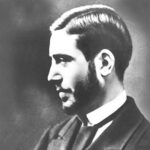 studying aviation. He joined the newly founded Société Aéronautique de France, and he became vice-president of the Society in 1876. He was a participant in the publication of the journal L’Aéronaute.
studying aviation. He joined the newly founded Société Aéronautique de France, and he became vice-president of the Society in 1876. He was a participant in the publication of the journal L’Aéronaute.
Pénaud excelled in developing model aircraft, and in 1870, made the first of a series of successful model helicopters. While the principle of this was not new, Pénaud upgraded the prior models with the addition of the first use of twisted rubber to power a flying model. During the early years of the development of heavier-than-air flight, many experimenters were to use this method of propulsion for experimental models, including Lawrence Hargrave and AV Roe.
In 1872, he developed a rubber-driven ornithopter. Both the helicopter and the ornithopter enjoyed some success as toys, but this was not what Pénaud wanted to do with his work. In 1873 he started collaborating with an engineer named Paul Gauchot, and produced two designs for full-sized aircraft…the first in 1874 and the second in 1876. The 1876 aircraft was drawn in detail for the purpose of patenting the ideas it incorporated, and had many remarkably advanced features, including electrically operated elevators, a fully enclosed cabin for the pilot, a retractable undercarriage, and the use of a pair of propellers rotating in opposite directions to eliminate the torque reaction caused by a single propeller. Pénaud also participated in lighter than air experimentation, and produced a number of ingenious devices, including a differential barometer to show the rate of ascent or descent. He really was a great innovator, but he just couldn’t raise much interest in his work.
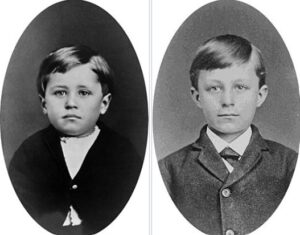
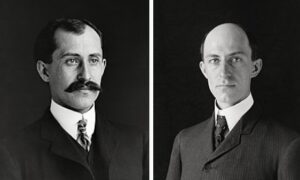 When Pénaud was unable to obtain any financial backing for his ambitious design. He gave up hope, and on October 22, 1880, at the age of 30, Pénaud committed suicide. Little did he know that twenty short years later, due in part to seeing his work, two preacher’s boys would actually invent a “flying machine” that worked. I think it is incredibly sad that he didn’t live to see that day.
When Pénaud was unable to obtain any financial backing for his ambitious design. He gave up hope, and on October 22, 1880, at the age of 30, Pénaud committed suicide. Little did he know that twenty short years later, due in part to seeing his work, two preacher’s boys would actually invent a “flying machine” that worked. I think it is incredibly sad that he didn’t live to see that day.

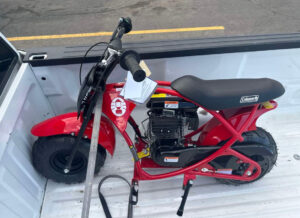 My grandnephew, Jaxon Killinger and his sister, Brooklyn, joined our family when his dad, Chris Killinger married my niece, Lacey (Stevens) Killinger, and we all feel very blessed to have these bonus children in our lives. It amazes me, just how fast these kids have grown in the relatively short time we have known them. They are both just as sweet as they can be, and they are really enjoying their new cousins, Elliott and Maya Stevens, who are Lacey’s brother, Garrett Stevens and his wife, Kayla’s children. It has been a win-win connection from the start.
My grandnephew, Jaxon Killinger and his sister, Brooklyn, joined our family when his dad, Chris Killinger married my niece, Lacey (Stevens) Killinger, and we all feel very blessed to have these bonus children in our lives. It amazes me, just how fast these kids have grown in the relatively short time we have known them. They are both just as sweet as they can be, and they are really enjoying their new cousins, Elliott and Maya Stevens, who are Lacey’s brother, Garrett Stevens and his wife, Kayla’s children. It has been a win-win connection from the start.
Jaxon got a dirt bike for his birthday, so he has really been enjoying riding around the block on it. He got it early, and got to take it to the lake, so he got to do a lot of riding out there too. He has been having a blast!! 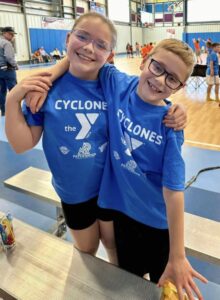
 He has really been enjoying the summer, but school is getting ready to start now. Jaxon will be in fourth grade this year, and he is really excited about that. However, it will be the first year that he isn’t in the same school as his sister, because Brooklyn is starting middle school this year. I don’t know if Jaxon has said that he is nervous, but even if he is, he will quickly adapt, and I think he will enjoy being in the “upper classes” of elementary school. Most kids find that they like being in the older group of kids. With the coming school year, also comes flag football, and this will be Jaxon’s first year playing flag football. In fact, this will be his first time playing football at all!! I’m sure he is really excited about that. Most boys like football, and Jaxon is no exception. Jaxon also loves to go to work with his dad, Chris Killinger. He likes to help out to earn money and of course, see all the cool planes!! What kid wouldn’t love to have that opportunity!! Jaxon feels very blessed to get to go.
He has really been enjoying the summer, but school is getting ready to start now. Jaxon will be in fourth grade this year, and he is really excited about that. However, it will be the first year that he isn’t in the same school as his sister, because Brooklyn is starting middle school this year. I don’t know if Jaxon has said that he is nervous, but even if he is, he will quickly adapt, and I think he will enjoy being in the “upper classes” of elementary school. Most kids find that they like being in the older group of kids. With the coming school year, also comes flag football, and this will be Jaxon’s first year playing flag football. In fact, this will be his first time playing football at all!! I’m sure he is really excited about that. Most boys like football, and Jaxon is no exception. Jaxon also loves to go to work with his dad, Chris Killinger. He likes to help out to earn money and of course, see all the cool planes!! What kid wouldn’t love to have that opportunity!! Jaxon feels very blessed to get to go.
Jaxon has been blessed with a bonus mom who loves him and his sister very much. Lacey has always had a soft 
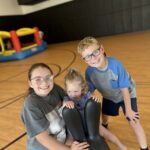 heart and a sweet nature, and she truly loves both of the children. Lacey is a licensed cosmetologist, and that has been a nice advantage for both of the children when it comes to their own personal hair style desires. Recently Jaxon decided that he wasted to have wavey hair, so he told Lacey, and she gave him a perm. I think his new style looks great, and what a great way for him to start the new school year. He is very excited about it. I think Jaxon is going to have a great school year. Today is Jaxon’s 9th birthday. Happy birthday Jaxon!! Have a great day!! We love you!!
heart and a sweet nature, and she truly loves both of the children. Lacey is a licensed cosmetologist, and that has been a nice advantage for both of the children when it comes to their own personal hair style desires. Recently Jaxon decided that he wasted to have wavey hair, so he told Lacey, and she gave him a perm. I think his new style looks great, and what a great way for him to start the new school year. He is very excited about it. I think Jaxon is going to have a great school year. Today is Jaxon’s 9th birthday. Happy birthday Jaxon!! Have a great day!! We love you!!

 My grandnephew, Matt Masterson, is the only son in a family with three kids. Of course, you know that the brother is always going to pick on his sisters, and Matt is no exception. When they were younger, of course, Matt, like most boys could tease almost to the point of being mean, but now “Bubba” as the girls often call him, is more mature and more kind to them. His sisters, Raelynn “Rae” and Taylor like going places with him and he doesn’t mind running them around when they need to go somewhere. Matt’s working so, he often uses his money to do things for his parents and sisters. Also, when he isn’t working, he likes gaming. Matt has paid for the girls to go see “Inside Out 2” and has bought both of them things like plushies and drinks when they’re out and about. Taylor tells me that Matt is the epitome of the person she wants to be, “He’s kind and funny as well as strong and protective. He knows how to hold himself in a tough situation and he knows when to just listen.” She says, “I love my older brother with more than my whole heart and it’s hard to think he’s 19 now.”
My grandnephew, Matt Masterson, is the only son in a family with three kids. Of course, you know that the brother is always going to pick on his sisters, and Matt is no exception. When they were younger, of course, Matt, like most boys could tease almost to the point of being mean, but now “Bubba” as the girls often call him, is more mature and more kind to them. His sisters, Raelynn “Rae” and Taylor like going places with him and he doesn’t mind running them around when they need to go somewhere. Matt’s working so, he often uses his money to do things for his parents and sisters. Also, when he isn’t working, he likes gaming. Matt has paid for the girls to go see “Inside Out 2” and has bought both of them things like plushies and drinks when they’re out and about. Taylor tells me that Matt is the epitome of the person she wants to be, “He’s kind and funny as well as strong and protective. He knows how to hold himself in a tough situation and he knows when to just listen.” She says, “I love my older brother with more than my whole heart and it’s hard to think he’s 19 now.”
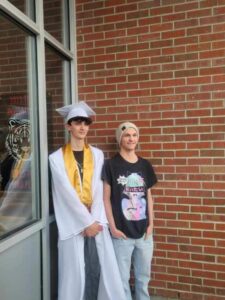
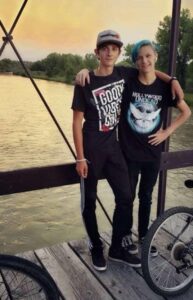
Matt’s mom, Dustie Masterson tells me, “Matthew has some goals for this coming year. He is going to get his GED and then he’s decided he wants to become a pharmacy technician with the option of college later to become a certified pharmacist. I’m so proud of him for taking the time to think through and decide what he wants to do in life.” She says, “Matt is single these days and loving it. He isn’t one for casual dating. He is far more conservative about that than other guys his age. He is mature in that he wants to be happy and refuses to settle for anything less.”
Matt works at GNC at the Eastridge Mall, as a key holder. He can open and close the store by himself and has been scheduled to do an open to close shift. He is becoming quite the salesman too. He is very good at suggestive marketing, which is the mark of a good salesman. Dustie says, “It’s that charming character of his, I’m sure. I think he could sell snow cones to an Eskimo.” Hahahahaha!!! That is a funny idea.
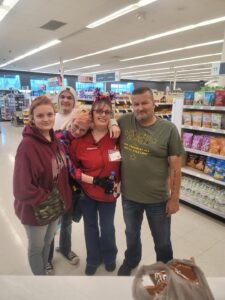

Dustie tells me that, “last but definitely not least, he is a good man. He takes care of his sisters like no other (I feel for anyone who tries to hurt them), and he takes care of his mama. He comes and says good morning every day, he will randomly stop in my work and check to see how I am and make sure I’m ok. He is so much like his dad (Rob Masterson) in that respect. He is a sensitive man, and I don’t mean in a bad way, but he can tell what people need and does everything in his power to see that those he cares about have their needs met.” I don’t think that better things can be said about a man than to have his loved ones tell of his goodness. That says it all. Today is Matt’s 19th birthday. Happy birthday Matt!! Have a great day!! We love you!!

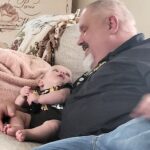 This year has been a “pretty lazy and laid-back year” for my nephew, Dave Balcerzak. He and my niece, Chantel Balcerzak got another grandson this year, named Nathaniel Andrew Kirk. He was born on January 15, 2024, to their daughter, Siara Kirk and her husband, Chris. Siara and Chris had purchased the house next door to Dave and Chantel, and Chantel babysits while Siara works. When Dave gets home, he immediately latches on to that little baby, and they hang out on the couch. My guess is that Dave is teaching Nathaniel the “sports ropes” so they can watch together sometime in the near future. Nathaniel is quite taken with Dave, and the feeling is mutual. Dave loves his grandbabies!!
This year has been a “pretty lazy and laid-back year” for my nephew, Dave Balcerzak. He and my niece, Chantel Balcerzak got another grandson this year, named Nathaniel Andrew Kirk. He was born on January 15, 2024, to their daughter, Siara Kirk and her husband, Chris. Siara and Chris had purchased the house next door to Dave and Chantel, and Chantel babysits while Siara works. When Dave gets home, he immediately latches on to that little baby, and they hang out on the couch. My guess is that Dave is teaching Nathaniel the “sports ropes” so they can watch together sometime in the near future. Nathaniel is quite taken with Dave, and the feeling is mutual. Dave loves his grandbabies!!
Dave has been interested in painting cars, and this year, he did first paint job on a car. He’s proud of that. Dave has had a project car for some time now. He has been fixing up his 1968 Pontiac Le Mans. Whenever he can, 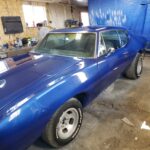
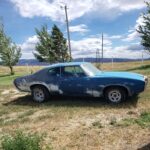 he’s out there working on the car getting it ready for driving, and especially painting. Then, in March, he was ready, so he took the dive and painted it himself. I think he did an amazing job on it.
he’s out there working on the car getting it ready for driving, and especially painting. Then, in March, he was ready, so he took the dive and painted it himself. I think he did an amazing job on it.
For Dave, Summer is the best time of year. He loves to putter around the yard and has just about every yard tool imaginable. Chantel was quick to clarify that that while Dave loves to take care of their lawn, and it is gorgeous, and the envy of the neighborhood, Dave is not a gardener, and totally hates gardening. Yardwork is a totally different, and Chantel says, “My man can edge the lawn like nobody’s business!!” I guess that there is just a difference between a garden and a yard, and for many men, that is a line not to be crossed.
Dave has been a lifelong Steelers fan. He loves football and enjoys having the kids come over to watch games with him. Another “football thing” that Dave loves is collecting football cards. Dave will spend hours down in his 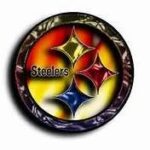
 “man cave” with those football cards…sorting them!! That is a practice that completely baffles Chantel, but it makes Dave happy, so she just laughs it off, and lets him do his thing. Chantel says that practice sounds “crazy boring,” but it keeps him entertained for hours!! Hey, if it keeps him entertained, I guess he isn’t bugging Chantel because he is bored, right??Chantel tells me that they have shifted into rest! That is really “marriage speak” for being content, and it’s a great place to be. Today is Dave’s birthday. Happy birthday Dave!! Have a great day!! We love you!!
“man cave” with those football cards…sorting them!! That is a practice that completely baffles Chantel, but it makes Dave happy, so she just laughs it off, and lets him do his thing. Chantel says that practice sounds “crazy boring,” but it keeps him entertained for hours!! Hey, if it keeps him entertained, I guess he isn’t bugging Chantel because he is bored, right??Chantel tells me that they have shifted into rest! That is really “marriage speak” for being content, and it’s a great place to be. Today is Dave’s birthday. Happy birthday Dave!! Have a great day!! We love you!!
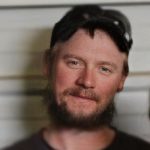
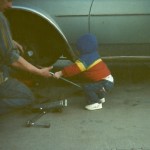 My nephew, JD Parmely is a mechanic extraordinaire!! He went to college in Arizona for that very thing. He has always been interested in mechanics, even as a little boy, when he would hand his uncle, Bob Schulenberg tool as he worked on a vehicle in the driveway of his grandpa, Walt Schulenberg’s house. My husband, Bob and his nephew, JD were a little team. They still work together sometimes today. It’s mostly when one or the other need some help on a vehicle, or they are a little stumped. JD is a really good resource, if Bob has a vehicle that is giving him trouble. JD has come a long way from the days when he was Bob’s little helper.
My nephew, JD Parmely is a mechanic extraordinaire!! He went to college in Arizona for that very thing. He has always been interested in mechanics, even as a little boy, when he would hand his uncle, Bob Schulenberg tool as he worked on a vehicle in the driveway of his grandpa, Walt Schulenberg’s house. My husband, Bob and his nephew, JD were a little team. They still work together sometimes today. It’s mostly when one or the other need some help on a vehicle, or they are a little stumped. JD is a really good resource, if Bob has a vehicle that is giving him trouble. JD has come a long way from the days when he was Bob’s little helper.
JD is a good hand to have around. He often helps his brothers, Barry Schulenberg and Eric Parmely. This year 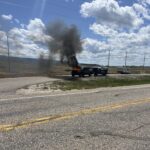
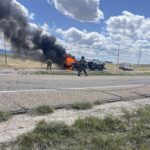 he was helping Eric build a new garage. It is going to be a fine garage, and quite big. The guys worked on it quite a while, but they made great progress. Eric and his wife Ashley will really like having that this winter. JD is proving to be quite handy in more areas than just mechanics. In reality, there are very few jobs JD won’t at least attempt to tackle. And if you are looking for an assistant on a job you are working on, JD is often your man. And he is a willing helper too.
he was helping Eric build a new garage. It is going to be a fine garage, and quite big. The guys worked on it quite a while, but they made great progress. Eric and his wife Ashley will really like having that this winter. JD is proving to be quite handy in more areas than just mechanics. In reality, there are very few jobs JD won’t at least attempt to tackle. And if you are looking for an assistant on a job you are working on, JD is often your man. And he is a willing helper too.
JD did run into a little “excitement” earlier this summer, when a pickup he was driving suddenly sprung a gas leak and caught on fire. Now that is get your adrenaline going, won’t it? JD was hauling another pickup for a 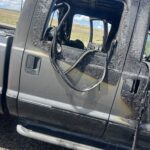
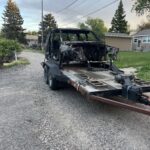 guy, and I’m sure you can imagine how quickly they got out of JD’s pickup. The fire department was called, but by the time they arrived, JD’s pickup was, well…toast!! JD decided that his liked the pickup, so he decided to rebuild it. It didn’t take him very long to find the necessary parts, and the pickup is back on the road. Most of us would have thought the truck just needed to go to the junk yard, but JD proved that it could still function as a truck. I guess that if the vehicle is a favorite, you do what you have to do. Today is JD’s birthday. Happy birthday JD!! Have a great day!! We love you!!
guy, and I’m sure you can imagine how quickly they got out of JD’s pickup. The fire department was called, but by the time they arrived, JD’s pickup was, well…toast!! JD decided that his liked the pickup, so he decided to rebuild it. It didn’t take him very long to find the necessary parts, and the pickup is back on the road. Most of us would have thought the truck just needed to go to the junk yard, but JD proved that it could still function as a truck. I guess that if the vehicle is a favorite, you do what you have to do. Today is JD’s birthday. Happy birthday JD!! Have a great day!! We love you!!
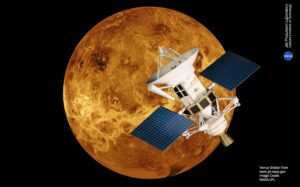
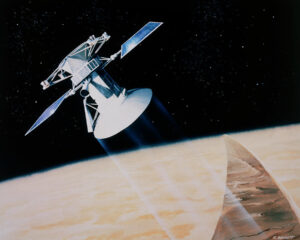 In the height of space travel, NASA decided to set up a mission to take pictures of Venus. The planet is always shrouded in a layer of clouds, with an extremely thick carbon dioxide atmosphere. When looking at Venus in visible light, those clouds are all you would see. That said, even a “flyby” would not give a good view of the planet, plus it would take a long time to get there, so it wasn’t feasible for a manned mission. Nevertheless, a mission was set up in March of 1988, for the purpose of “checking it out.” It was announced by NASA that astronauts Walker, Grabe, Lee, Thagard, and Cleave would be the crew of the STS-30 mission to release the Magellan spacecraft for the flight planned for late April 1989. Thagard had flown twice before, on STS-7 in June 1983 and the STS-51B Spacelab 3 mission in April-May 1985. Walker, Grabe, and Cleave had each flown once before, on STS-51A, STS-51J, and STS-61B, respectively. STS-30 would be Lee’s first trip into space. Walker and Thagard joined NASA in the astronaut class of 1978, Grabe and Cleave joined in 1980, and Lee in 1984. The mission would take four days, during which they would deploy Magellan and its Inertial Upper Stage (IUS) on the first flight day. There was a 29-day window for the deployment of Magellan, as dictated by the alignments of Venus and Earth to achieve the proper trajectory for the journey to its destination. Once it was released, their job, as far as Magellan was essentially over.
In the height of space travel, NASA decided to set up a mission to take pictures of Venus. The planet is always shrouded in a layer of clouds, with an extremely thick carbon dioxide atmosphere. When looking at Venus in visible light, those clouds are all you would see. That said, even a “flyby” would not give a good view of the planet, plus it would take a long time to get there, so it wasn’t feasible for a manned mission. Nevertheless, a mission was set up in March of 1988, for the purpose of “checking it out.” It was announced by NASA that astronauts Walker, Grabe, Lee, Thagard, and Cleave would be the crew of the STS-30 mission to release the Magellan spacecraft for the flight planned for late April 1989. Thagard had flown twice before, on STS-7 in June 1983 and the STS-51B Spacelab 3 mission in April-May 1985. Walker, Grabe, and Cleave had each flown once before, on STS-51A, STS-51J, and STS-61B, respectively. STS-30 would be Lee’s first trip into space. Walker and Thagard joined NASA in the astronaut class of 1978, Grabe and Cleave joined in 1980, and Lee in 1984. The mission would take four days, during which they would deploy Magellan and its Inertial Upper Stage (IUS) on the first flight day. There was a 29-day window for the deployment of Magellan, as dictated by the alignments of Venus and Earth to achieve the proper trajectory for the journey to its destination. Once it was released, their job, as far as Magellan was essentially over.
STS-30 lifted off on May 4, 1989, utilizing space shuttle Atlantis, which was on its third space flight. Of course, STS-30 lifted off from NASA’s Kennedy Space Center (KSC) in Florida. Its five-person crew included Commander David M Walker, Pilot Ronald J Grabe, and Mission Specialists Mark C Lee, Norman E Thagard, and Mary L Cleave. They flew a four-day mission that deployed the Magellan spacecraft, which was then managed by NASA’s Jet Propulsion Laboratory in Southern California, to study Venus. This mission would unite NASA’s human and interplanetary spaceflight programs. It also marked the first US planetary launch since 1978. The astronauts successfully deployed Magellan and its upper stage on their first day in space, sending the spacecraft off on its 15-month journey to Venus. I can imagine that it was an exciting venture for them.
Once Magellan arrived at the cloud-shrouded planet, it spent four years mapping Venus in unprecedented detail. The mission vastly increased human knowledge of the planet. The Magellan spacecraft arrived at Venus on August 10, 1990. Using radar imaging, Magellan began its primary goal of mapping the surface of Venus. The radar imaging was able to “peek” through the thick clouds which made visual observation difficult. While there, Magellan made the first global map of the surface of Venus and global maps of the planet’s gravity field. It was inserted into a near-polar elliptical orbit and continued its mission for several years. After its journey to Venus, the Magellan spacecraft, finally arrived at Venus in 1990. It then made the first global map of the surface of Venus as well as global maps of the planet’s gravity field. NASA was quite surprised at the findings 
 Magellan produced, including the fact that it had a relatively young planetary surface that was probably formed by lava flows from planet-wide volcanic eruptions. After completing its four-year flight mission, NASA deliberately plunged the Magellan spacecraft to the surface of Venus in October 1994 to gather data on the planet’s atmosphere before it ceased operations. It marked the first time an operating planetary spacecraft had been intentionally crashed.
Magellan produced, including the fact that it had a relatively young planetary surface that was probably formed by lava flows from planet-wide volcanic eruptions. After completing its four-year flight mission, NASA deliberately plunged the Magellan spacecraft to the surface of Venus in October 1994 to gather data on the planet’s atmosphere before it ceased operations. It marked the first time an operating planetary spacecraft had been intentionally crashed.

